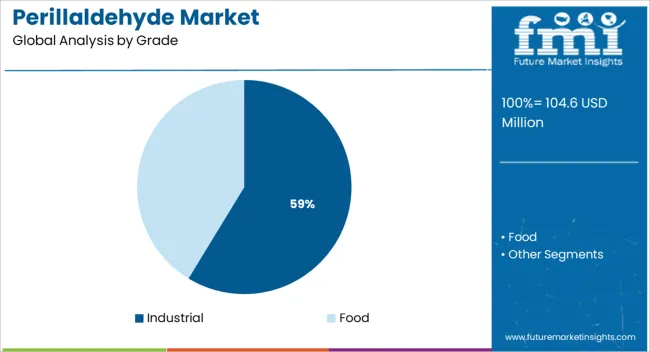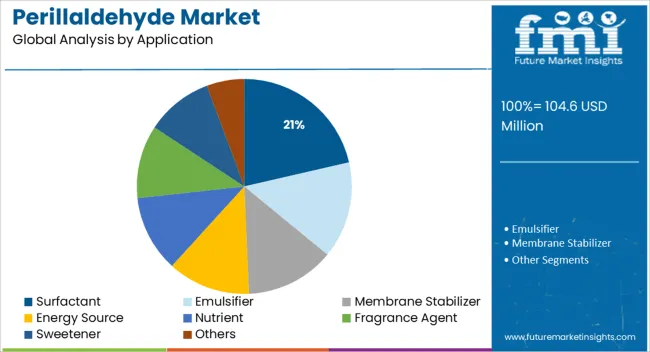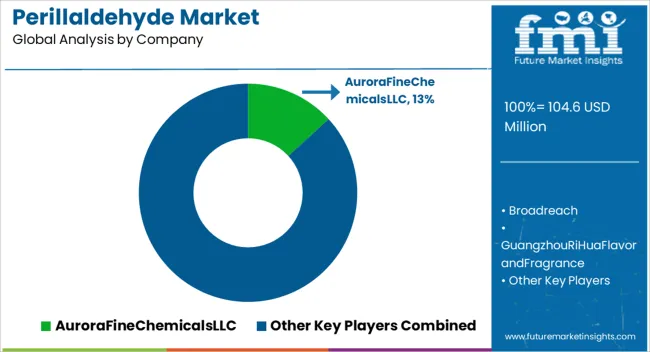The Perillaldehyde Market is estimated to be valued at USD 104.6 million in 2025 and is projected to reach USD 153.4 million by 2035, registering a compound annual growth rate (CAGR) of 3.9% over the forecast period.

| Metric | Value |
|---|---|
| Perillaldehyde Market Estimated Value in (2025 E) | USD 104.6 million |
| Perillaldehyde Market Forecast Value in (2035 F) | USD 153.4 million |
| Forecast CAGR (2025 to 2035) | 3.9% |
The perillaldehyde market is experiencing upward momentum driven by its growing relevance in fragrance formulations, agrochemicals, and personal care ingredients. Rising demand for naturally derived aromatic compounds has positioned perillaldehyde as a high-value additive in clean-label and bio-based formulations. Industry stakeholders are increasingly aligning with sustainable extraction practices and regulatory frameworks that favor low-toxicity and biodegradable components, boosting adoption across regulated end markets.
Innovations in downstream processing and isolation techniques are enabling cost-effective scalability while maintaining desired purity and olfactory performance. Additionally, consumer preferences for non-synthetic fragrance and flavor components are contributing to consistent uptake across multiple verticals.
As industries move toward greener chemistry, the integration of perillaldehyde into surfactants, flavoring agents, and intermediate synthesis is expanding its footprint. Continued investments in sustainable sourcing, combined with advancements in fermentation and botanical extraction, are expected to support the market's future growth.
The market is segmented by Grade, Source, Application, and End-Use and region. By Grade, the market is divided into Industrial and Food. In terms of Source, the market is classified into Natural and Synthetic. Based on Application, the market is segmented into Surfactant, Emulsifier, Membrane Stabilizer, Energy Source, Nutrient, Fragrance Agent, Sweetener, and Others. By End-Use, the market is divided into Food & Beverage, Personal Care & Cosmetics, Water Treatment, and Industrial Manufacturing. Regionally, the market is classified into North America, Latin America, Western Europe, Eastern Europe, Balkan & Baltic Countries, Russia & Belarus, Central Asia, East Asia, South Asia & Pacific, and the Middle East & Africa.

The industrial grade segment is expected to hold 58.7% of the total market revenue in 2025, making it the leading grade category. This leadership is driven by large-scale use of perillaldehyde in fragrance compounds, detergents, and agricultural intermediates, where ultra-high purity is not always required.
Industrial grade perillaldehyde is preferred in applications demanding consistent aromatic performance and chemical stability at an optimized cost, particularly in manufacturing environments with bulk-volume processing. The scalability of industrial grade production supports a wide range of downstream uses, enabling formulators to leverage its strong olfactory profile across diverse product lines.
Additionally, its utility in surfactants and disinfectants has increased following rising awareness about eco-friendly raw materials in industrial cleaning and personal care products. These factors continue to support the segment’s dominant position in the perillaldehyde value chain.

In the source category, the natural segment is projected to account for 66.2% of total market share in 2025, positioning it as the most preferred source. This dominance is fueled by increasing regulatory and consumer push toward plant-derived ingredients, especially in fragrance, cosmetic, and flavoring applications.
Natural perillaldehyde extracted from botanical sources such as perilla and citrus peels is perceived as safer, cleaner, and more environmentally responsible. Brands and formulators are responding to clean-label trends by reformulating product lines with recognizable, minimally processed ingredients.
In markets like personal care and food flavorings, the demand for transparency and sustainability has elevated natural variants to the forefront. Technological advancements in botanical extraction and traceability have further enabled the consistent supply of natural perillaldehyde, reinforcing its leading market position.

The surfactant segment is forecast to represent 21.4% of total market revenue in 2025, leading among all application segments. This growth is being driven by increasing demand for multifunctional surfactants that combine cleaning efficacy with sensory appeal, particularly in personal care and home care formulations.
Perillaldehyde’s distinct fragrance characteristics and compatibility with natural emulsifiers have contributed to its rising use in surfactant systems aimed at premium and eco-friendly product lines. Its performance in mild cleansing solutions and ability to enhance product aesthetics without synthetic additives is valued in formulations targeting skin-sensitive consumers.
Additionally, perillaldehyde’s low volatility and functional stability in aqueous systems make it suitable for integration into diverse surfactant applications, from shampoos and body washes to household cleaners. These characteristics continue to strengthen its role as a preferred aromatic component in modern surfactant design.
The analysis of Perillaldehyde demand from 2020 to 2024 showed a historical growth rate of less than 2.7% CAGR, with the general expansion of the food & beverage & pharmaceutical industry due to an increase in consumer income, urbanization as well a growing population.
The COVID-19 pandemic first caused recessionary downturns that temporarily dashed growth expectations through fewer industrial manufacturer sales, retail closings, production cycle interruptions, and stringent regulations.
However, since infection curves have flattened from 2025, industrial production activity in important markets has restarted. As a result, FMI’s Perillaldehyde demand projection predicts a CAGR of 3.9% by 2035. Additionally, it is employed in many different fields, including flavouring agents, perilla alcohol manufacture, cosmetics, pharmaceuticals, and other industries, and utilized in several other industries across the world.
The market for Perillaldehyde is expected to rise as a result of the trend toward adopting a fast-paced lifestyle, which has increased the consumption of packaged and processed foods. Sales of cosmetics and personal care items have increased as a result of rising disposable money and a greater propensity among young people to style, maintain good cleanliness and beautify themselves for improved self-representation.
Therefore, it is estimated that the increasing consumption of cosmetics and personal care products will increase the demand for Perillaldehyde. Water and waste treatment are modern aspects of every city. Increasing government initiatives and increasing awareness of hygiene and sanitation are increasing the number of water treatment projects, which is expected to have a positive impact on the growth of the market.
The global food and beverage industry's rapid expansion is the main driver of the Perillaldehyde market's expansion. The increase in consumer spending and the growth of the urban population have led to changes in food choices and eating patterns. Rapid growth in industrial activities especially in developing countries is expected to have a positive impact on market growth.
Stringent government regulations banning the use of toxic chemicals and increasing demand for organic products made from natural ingredients are limiting the growth of the Perillaldehyde market.
Many countries only allow the sale of items mainly for food that is considered safe for use. This approval often takes a long time and limits opportunities for expansion. In addition, some cosmetic and medicinal chemicals can cause genetic mutations, birth defects or reproductive disorders, genetic mutations, and cancer, all of which are expected to limit the market growth.
Increased research and development activities by market players aiming to develop advanced and diversified product portfolios may provide new opportunities for the growth of the Perillaldehyde market.
Natural Perillaldehyde is a natural organic compound that has been used for over 100 years. It is found in plants and has a sweet, woody scent. And this compound can be used in various applications such as fragrance, production of perilla alcohol, cosmetics, and pharmaceuticals. It is also used in various regions around the world.
The growing demand for cosmetics, food and beverage, and pharmaceutical industries as well as increasing consumer’s perspective toward natural products is anticipated to boost the demand for natural Perillaldehyde.
Geographically, the market is segmented into six regions namely North America, Latin America, Asia Pacific, Europe, and MEA. Asia-Pacific is considered to be the most important market for Perillaldehyde and is expected to hold the largest share in the near future. The growth of the Perillaldehyde market in the Asia-Pacific region is expected to be driven by growth in the food and beverages, cosmetics and personal care, and water treatment industries.
The Perillaldehyde market is expected to grow moderately in the North American region. Various factors underlying the growth of the Perillaldehyde market in the region are the dominance of end-consumer industries, and increasing consumption of processed foods, cosmetics, and personal care products, among others.
Moreover, the implementation of government incentive policies to boost manufacturing growth is expected to act as a major driver of product demand in the region. Increased investments in manufacturing activities in Europe are expected to boost the demand for Perillaldehyde in the upcoming forecast period. Also, increasing consumption of processed foods is expected to boost market growth in the region.

Key players operating in the Perillaldehyde market include Hunan Farida Technology, Inoue Perfumery MFG, Nanjing Lianye Chemical, Guangzhou Ri Hua Flavour & Fragrance, Broadreach, Merck K GAA, Penta Manufacturing Company, TCI Chemicals India Ltd, and Triveni Chemicals
The Perillaldehyde market is highly consolidated, with a limited number of large-scale vendors having the lion's share. The primary strategies taken by the key players in the food, pharmaceutical, and Perillaldehyde market are product expansion and mergers and acquisitions.
They also engage in mergers and acquisitions and collaborations while obtaining regulatory permissions.
| Attribute | Details |
|---|---|
| Growth Rate | CAGR of XX% from 2025 to 2035 |
| Base Year for Estimation | 2024 |
| Historical Data | 2020 to 2024 |
| Forecast Period | 2025 to 2035 |
| Quantitative Units | Revenue in USD Million, Volume in Tons and CAGR from 2025 to 2035 |
| Report Coverage | Revenue Forecast, Volume Forecast, Company Ranking, Competitive Landscape, Growth Factors, Trends and Pricing Analysis |
| Segments Covered | Grade, source, Application, End-Use, Region |
| Regions Covered | North America; Latin America; Europe; East Asia; South Asia & Pacific; Middle East and Africa |
| Key Countries Covered | USA, Canada, Mexico, Brazil, Germany, UK, France, Italy, Spain, Russia, China, Japan, India, GCC Countries, Australia |
| Key Companies Profiled | Aurora Fine Chemicals LLC; Broadreach; Guangzhou Ri Hua Flavorand Fragrance; Hunan Farida Technology; Inoue Perfumery MFG; Merck KGaA; Nanjing Lianye Chemical; Penta Manufacturing Company; TCI Chemicals India Ltd; Triveni Chemicals |
| Customization & Pricing | Available upon Request |
The global perillaldehyde market is estimated to be valued at USD 104.6 million in 2025.
The market size for the perillaldehyde market is projected to reach USD 153.4 million by 2035.
The perillaldehyde market is expected to grow at a 3.9% CAGR between 2025 and 2035.
The key product types in perillaldehyde market are industrial and food.
In terms of source, natural segment to command 66.2% share in the perillaldehyde market in 2025.






Full Research Suite comprises of:
Market outlook & trends analysis
Interviews & case studies
Strategic recommendations
Vendor profiles & capabilities analysis
5-year forecasts
8 regions and 60+ country-level data splits
Market segment data splits
12 months of continuous data updates
DELIVERED AS:
PDF EXCEL ONLINE

Thank you!
You will receive an email from our Business Development Manager. Please be sure to check your SPAM/JUNK folder too.
Chat With
MaRIA